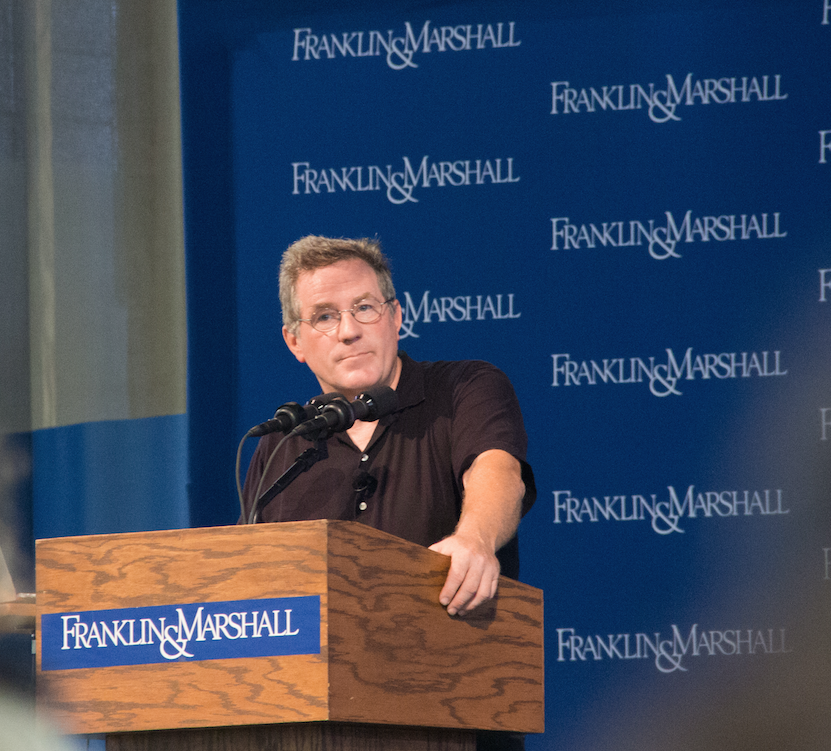By Christa Rodriguez || Campus Life Editor

This week’s Common Hour speaker, as part of F&M’s Sustainability Week, was Joel Sartore, a National Geographic wildlife photographer. Sartore presented on his life, career, and photo project titled “The Photo Ark,” an ongoing multi-year documentary with photos of every captive species that exists today. In addition to contributing to National Geographic magazine for twenty years, Sartore is a speaker, author, teacher, conservationist, and a National Geographic Fellow. His photography is currently on display at the National Geographic Museum in Washington D.C.
Sartore started Common Hour discussing his career with National Geographic, saying the humor in his photographs is what caught their attention. Every assignment for National Geographic is freelance–they give him a topic and tell him to do his best. He photographed a range of subjects from the events of a Nebraska state fair to animals in the wild. Many times, Sartore was assigned to go back and re-photograph people years later.
Conservation photography, to Sartore, tends to be more heavy than his other photography. He contrasted his images of endangered and captured wildlife by first showing the Common Hour crowd funny images such as his children throwing fits or his comical Christmas cards. Sartore stated that pictures of animals have to be more interesting and engaging. The pictures often have to be more competitive with other pictures in the magazine and even the photographs on the internet. He noted that, “you’re only as good as your last story.” For example, when Sartore chose to photograph bears, he decided to capture images that depicted their intelligence rather than violence or other more common perceptions of them.
Sartore recently visited a koala hospital in Australia, where many koalas were bitten by dogs or hit by cars. At the hospital, he photographed a week’s worth of dead koalas killed by cars. These photos quickly went viral, which led to Australia’s decision to start federal protection for koalas. In this case, his photo caught attention as well as sparked a major change.
Sartore told of his wife’s diagnosis of breast cancer and how that affected his career. While home, he began thinking about artists who focused on single subjects. He talked about John James Audubon, who focused specifically on painting North American birds. Once his wife was in recovery, he resumed photography, focusing on birds like Audubon. Soon the idea of the Photo Ark was born, his idea being to photograph every captive animal in the world. He also took studio portraits of animals that were in danger of extinction. This included very rare amphibians and, in some cases, there were just three, two, or even one left in the world.
Sartore spoke on the harm of losing a species of an animal forever. For about ten years, he has been shooting many animals for Photo Ark that are close to extinction. He noted that when species die, “we’re really sad and we write stories in the news about it and then we do it all over again.” He said he does not get depressed however, but mostly more inspired to wake people up. He said of the animals, “they’re intelligent, they’re thoughtful, they’re full of grace.” According to Sartore, these animals have a right to live as much as humans.
In many photos, he tries to make the animals look anthropomorphic, for example, having them stand on their hind legs. This makes people respond more to the photos and makes them more inclined to see the animals as worth saving.
It will take a total of 25 years to complete the Photo Ark, as it will take that long to photograph all the animals in captivity around the world. According to Sartore, places like zoos are the only places that have certain animals because many times their habitats are taken away by human development. However, Sartore notes he would rather have a species thrive in a zoo than go extinct.
He commented that most people do not think about biodiversity or its effects on human life. Sartore said, “we ignore these animals that are in peril” when we need these animals to survive. The Photo Ark, to him, is a way to educate people and show that it is not too late to save these animals. He used the giant panda as an example of many formerly dying species that is now stable because of human efforts. He highlighted that in many cases, species become stable or are saved by people that care and spend a little of their time doing something for the cause. Sartore showcased how saving animals does not have to be part of a career or an enormously large effort. He stressed that ordinary people have the power to change the world, through simple acts such as being aware of what you are spending money on, who the money goes to, and what that money ultimately supports. He concluded, “think what you can do…to make a difference. All of us have the power to make the world a better place. Anything is better than nothing.”
Sophomore Christa Rodiguez is the Campus Life Editor. Her email is crodrigue@fandm.edu.
Photo Courtesy of Arun Ramkissoon.